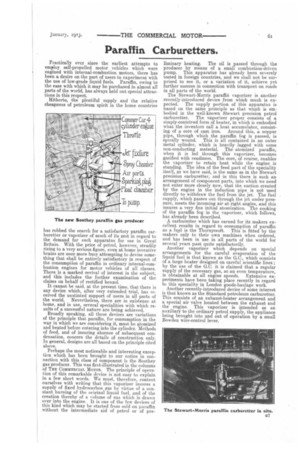Paraffin Carburetters.
Page 83

If you've noticed an error in this article please click here to report it so we can fix it.
Practically ever since the earliest attempts to employ self-propelled motor vehicles which were engined with internal-combustion motors, there has been a desire on the part of users to experiment with the use of low-grade liquid fuels. Paraffin, owing to the ease with which it may be purchased in almost all parts of the world, has always held out special attractions in this respect. Hitherto, the plentiful supply and the relative cheapness of petroleum spirit in the home countries has robbed the search for a satisfactory paraffin carburetter or vaporizer of much of its zest in regard to the demand for such apparatus for use in Great Britain. With the price of petrol, however, steadily rising to a very serious figure, even at home inventive brains are once more busy attempting to devise something that shall be entirely satisfactory in respect of the consumption of paraffin in ordinary internal-combustion engines for motor vehicles of all classes. There is a marked revival of interest in the subject, and this includes the further examination of the claims on behalf of rectified benzol.
It cannot be said, at the present time, that there is any device which, after very extended trial, has received the unstinted support of users in all parts of the world. Nevertheless, there are in existence at home, and in use, several specialities with which results of a successful nature are being achieved.
Broadly speaking, all these devices are variations of the principle that paraffin, for consumption in the way in which we are considering it, must be atomized and heated before entering into the cylinder. Methods of feed, and of insuring absence of subsequent condensation, concern the details of construction only. In general, designs are all based on the principle cited above.
Perhaps the most noticeable and interesting exception which has been brought to our notice in connection with this class of component is the Southey gas producer. This was first-illustrated in the columns of THE COMMERCIAL MOTOR. The principle of operation of this remarkable device is not easy to. explain in a few short words. We must, therefore, content ourselves with writing that this vaporizer insures a supply of fixed hydrocarbon gas by virtue of a constant burning of the original liquid fuel, and of the creation thereby of a volume of as which is drawn over into the engine. It is one of the few devices of this kind which may be started from cold on paraffin without the intermediate aid of petrol or of pre liminary heating. The oil is passed through the producer by means of a small combustion-driven pump. This apparatus has already been severely tested in foreign countries, and we shall not be surprised to see it, or a variation of it, achieve yet further success in connection with transport on roads in all parts of the world. The Stewart-Morris paraffin vaporizer is another recently-introduced device from which much 18 expected. The supply portion of this apparatus is based on the same principle as that which is embodied in the well-known Stewart precision petrol carburetter. The vaporizer proper consists of a simply-contrived form of heater, in which is embodied what the inventors call a heat accumulator, consisting of a core of cast iron. Around this, a copper pipe, through which the paraffin fog is passed, is spirally wound. This is all contained m an outer metal cylinder, which is heavily lagged with some non-conducting material. The atomized paraffin, when it is led through this vaporizer, becomes gasified with readiness. The core, of course, enables the vaporizer to retain heat while the engine is standing. The idea of the feed part of the speciality itself, as we have said, is the same as in the Stewart precision carburetter, and in this there is such an arrangement of component parts, into which we need not enter more closely now, that the suction created by the engine in the induction pipe is not used directly to withdraw the fuel from the jet. The fuel supply, which passes out through the jet under pressure, meets the incoming air at right angles, and this insures a very fine initial atomization. The cooking of the paraffin fog in the vaporizer, which follows, has already been described.
• A carburetter which has earned for its makers excellent results in regard to consumption of paraffin as a fuel is the Thornycroft. This is fitted by the makers only to their own machines when ordered, and has been in use in all parts of the world for several years past quite satisfactorily.
Another vaporizer which depends on special arrangements for the careful evaporation of the liquid fuel is that known as the 0.0., which consists of a. large heater designed on careful scientific lines ; by the use of the 0.0. it is claimed that a regular supply of the necessary gas, at an even temperature, is obtainable at all engine speeds. Extensive experiments have been taking place recently in regard to this speciality in London goods-haulage work. Another recently-introduced device of some interest is that known as the Standard petroleum carburetter. This consists of an exhaust-heater arrangement and a special air valve located between the exhaust and the . engine. This vaporizer is intended OA an auxiliary to the ordinary petrol supply, the appliance being brought into and out of operation by a small Bowden wire-control lever.


























































































